In the first part of the history of Dr. You could read Martens how it all began, today we continue with the subcultural background.
Singer Pete Townshend of the band The Who changed his interest in the boots when he wore them on stage.
What he did as an expression of pride in his working class heritage made many young people want to wear the shoe.
As a sign of the uprising of the proletariat, as a left-wing political symbol, as a sign of belonging to various emerging music genres and scenes, and simply for fashion reasons.
Anyone going through or past puberty knows the desire for differentiation, provocation and a sense of belonging, all made possible by the 1460.
Accordingly, it is no wonder that punks and docs also found each other. As music genres continued to intertwine, Dr. Martens also worn by Depeche Mode members and dark wave icon Anne Clark. Inspired by the New and Dark Wave, Goths also liked the high 10 or 20-hole lace-up boots.
I myself am a child of the 90s and to be honest I'm a bit jealous that I couldn't experience a big youth movement anymore because a lot was fought for before I was born. I grew up in a time when parents are no longer shocked when you secretly ask Dr. Martens buys, but experience with us in the Pick Up how mothers and fathers encourage their children to choose their first Docs.
In the same way, long-standing regular customers come with a green Iroquois and smile all over their faces because they are taking a new pair of boots home with them. Likewise, some people become nostalgic and deliberately buy their shoes for the office with the yellow seam and not the plain-colored counterpart, with the words "I didn't used to be fitted either, I keep a bit of it."
At least since Beyoncé outfitted her dance crew with colorful 1460s at the Coachella Festival, there's no denying that Docs have arrived in pop culture.
And that's exactly what makes the cult of these shoes - connecting all sorts of different people, genres and scenes! From the symbol of the working class to the symbol of diversity and tolerance in society. You've come a long way, Dr. martens

